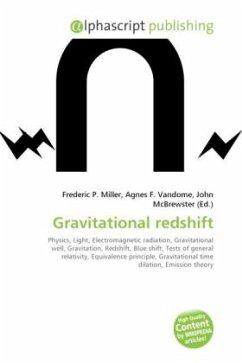In physics, light or other forms of electromagnetic radiation of a certain wavelength originating from a source placed in a region of stronger gravitational field (and which could be said to have climbed "uphill" out of a gravity well) will be found to be of longer wavelength when received by an observer in a region of weaker gravitational field. If applied to optical wave-lengths this manifests itself as a change in the colour of the light as the wavelength is shifted toward the red (making it less energetic, longer in wavelength, and lower in frequency) part of the spectrum. This effect is called gravitational redshift and other spectral lines found in the light will also be shifted towards the longer wavelength, or "red," end of the spectrum. This shift can be observed along the entire electromagnetic spectrum. Light that has passed "downhill" into a region of stronger gravity shows a corresponding increase in energy, and is said to be gravitationally blueshifted.
Bitte wählen Sie Ihr Anliegen aus.
Rechnungen
Retourenschein anfordern
Bestellstatus
Storno








